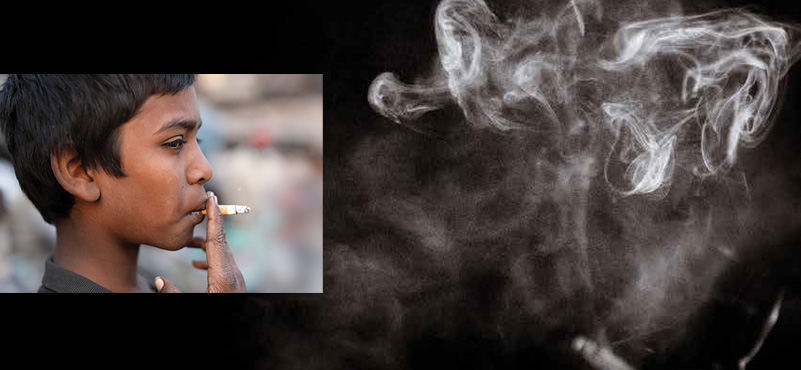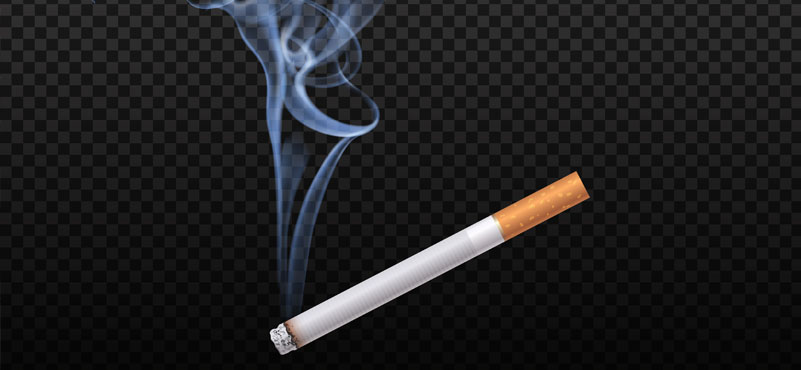ON THE OCCASION OF WORLD NO-TOBACCO DAY CELEBRATIONS!
The tobacco epidemic is one of the biggest public health threats killing about 13.5 lakh people in India each year. Worldwide, tobacco use causes more than seven million deaths per year and if the pattern of smoking globally does not change, more than eight million people annually will die from diseases related to tobacco use by 2030. The economic costs of tobacco use are substantial and include significant health care costs for treating the diseases caused by tobacco use as well as the lost human capital that results from tobacco-attributable morbidity and mortality.
Different tobacco products pose varying levels of health risk to users. Tobacco use is a major risk factor for cardiovascular and respiratory diseases, over 20 different types or subtypes of cancer, and many other debilitating health conditions. Tobacco smoke contains over 70 known cancer-causing chemicals. Nicotine is one of more than 4,000 chemicals found in tobacco smoke and is the primary component that acts on the brain. High levels of nicotine in smokeless tobacco are readily absorbed through the skin and mucosal lining of the mouth which is responsible for oral cancers. Also, environmental tobacco smoke, or second-hand smoke, has been shown to cause adverse health effects in people of all ages. The impact of tobacco use is not limited to mortality rates, but also affects quality of life and attempts to cope with poor mental health impacting your everyday life. Tobacco use affects your physical functioning, social functioning, vitality, general health and mental health. Smoking can affect your breathing, causing coughing and shortness of breath, increased fatigue, loss of fertility, menstrual problems etc. It increases the risk of respiratory tract infection, including bronchitis which can significantly reduce your quality of life.
While there has been increased awareness over time of the physical effects of tobacco, the mental affects are often left out of the conversation. The mental health challenges begin with addiction. Besides, addiction being a mental illness itself, tobacco and nicotine addiction can add extra stress to your life through the struggle to maintain the addiction. The nicotine in cigarettes can cause symptoms similar to anxiety. Tobacco use is strongly associated with a variety of psychiatric disorders. Tobacco users especially smokers are more likely to have mental health conditions, such as mood disorders, anxiety disorders and psychosis.
Government of India played a prominent role in the negotiations and drafting of the WHOFCTC, which culminated into the World Health Assembly of the World Health Organization (WHO) adopting the Framework Convention on Tobacco Control (FCTC) at its 56th Session on 21st May 2003. It is relevant to mention that at the same time the Indian Parliament unanimously passed the COTPA, 2003 Bill on 30th April 2003(a comprehensive Tobacco Control Law) which received the assent of the President on the 18th May, 2003. Subsequently India signed the WHOFCTC on 10th September 2003 and ratified the treaty on 5th February 2004, thereby confirming its obligation to perform and carry out the stipulations contained in the treaty.
 India played a key role in regulating tobacco use and its consumption by enacting the Cigarettes and Other Tobacco Products Act, 2003 (COTPA) to prohibit advertisement of, and to provide for the regulation of trade and commerce in, and production, supply. Under COTPA, many States have taken effective steps for prohibition on smoking in public spaces, prohibition on all forms of direct/indirect advertisement, promotion and sponsorship of tobacco products, prohibition on sale of tobacco products to minors as well as within a radius of 100 yards of educational institutions, and mandatory depiction of specified pictorial health warnings on all tobacco products. However, COTPA is best implemented when there are coordinated efforts in the direction by effectively involving various enforcement agencies and other stakeholders.
India played a key role in regulating tobacco use and its consumption by enacting the Cigarettes and Other Tobacco Products Act, 2003 (COTPA) to prohibit advertisement of, and to provide for the regulation of trade and commerce in, and production, supply. Under COTPA, many States have taken effective steps for prohibition on smoking in public spaces, prohibition on all forms of direct/indirect advertisement, promotion and sponsorship of tobacco products, prohibition on sale of tobacco products to minors as well as within a radius of 100 yards of educational institutions, and mandatory depiction of specified pictorial health warnings on all tobacco products. However, COTPA is best implemented when there are coordinated efforts in the direction by effectively involving various enforcement agencies and other stakeholders.
The National Tobacco Control Program (NTCP) launched by Ministry of Health and Family Welfare, Government of India to bring about greater awareness about the harmful effects of tobacco use and tobacco control laws as well as to facilitate effective implementation of the tobacco control laws. Such efforts have resulted in greater awareness among the masses and have led to tobacco control.
For effective design and proper implementation of policies, evidence is crucial. And when it comes to tobacco consumption, ample evidence is available on its consumption patterns, health and economic harms and policy measures which may help curb its growing addiction.
The latest available Global Adult Tobacco Survey 2016-17 (GATS 2) indicated that a staggering 28.6% or roughly 26 crore Indians, above 15 years of age, were consuming tobacco in some form! Of these, 23 crores were daily users and 19 crores were in rural India. Smokeless tobacco or gutkha was the most consumed tobacco product. Consumption varied widely across the states, from 64.5% in Tripura to 9.7% in Goa. However, it was reassuring that from GATS 1 to GATS 2, prevalence of tobacco consumption in any form came down by 6% and it is hoped that results from GATS 3, which is currently underway, will continue this downward trend!
 As for prevalence of tobacco consumption among youth, the latest Global Youth Tobacco Survey 2019 data indicated that 8.5% of students, in the age group 13-15 years, consumed tobacco in some form in the country, which is a marked improvement from 14.6% students who consumed tobacco in India as per GYTS 2009 data. Again, there were wide variations across the states – from as worryingly high as 58% in Arunachal Pradesh and Mizoram to as calmingly low as 1.1% in Himachal Pradesh.
As for prevalence of tobacco consumption among youth, the latest Global Youth Tobacco Survey 2019 data indicated that 8.5% of students, in the age group 13-15 years, consumed tobacco in some form in the country, which is a marked improvement from 14.6% students who consumed tobacco in India as per GYTS 2009 data. Again, there were wide variations across the states – from as worryingly high as 58% in Arunachal Pradesh and Mizoram to as calmingly low as 1.1% in Himachal Pradesh.
These impersonal statistics on tobacco consumption, however, have very real and alarming implications on our public health and economy. What are these?
As per ‘India: Health of the Nation’s States’ report, 2017 by Indian Council of Medical Research, it was estimated that the proportion of deaths due to Non-Communicable Diseases (NCDs) in India increased from 37.9% in 1990 to 61.8% in 2016, and further to 66% by 2019, as per a WHO estimate. The rising burden of NCDs is even surpassing the burden of Communicable diseases like water-borne or vector borne diseases, TB, HIV, etc. And tobacco use is a leading risk factor for NCDs attributable to nearly 13.5 lakh deaths every year, as identified by the Government of India itself.
Further, in September 2022, the Parliament Standing Committee on Health submitted the 139th Report on Cancer Care Plan and Management in which it noted that in India, the highest number of lives lost is due to oral cancer caused by tobacco, followed by cancer of the lungs, oesophagus and stomach. The Committee also noted that in India, tobacco use in different forms accounts for nearly 50% of all cancers that are preventable.
The health burden of tobacco consumption is evident and unmistakable. But the economic burden of tobacco consumption presents an equally stark picture – it was estimated to be a whopping Rs.1.77 lakh crore in 2017, or roughly 1.04% of India’s GDP. Research also indicates that tobacco pushes people into poverty and the number of people suffering impoverishment in India due to tobacco consumption could be as high as 15 million!
Legalising CBD & Ban on Electronic Cigarettes
There has been a big move towards legalising some kinds of CBD and other substances as not just less harmful but also possibly positive in impact for health. The Narcotic Drugs and Psychotropic Substances Act, 1985 (NDPS Act) outlaws the recreational use of cannabis. The NDPS Act, does not apply to the leaves and seeds of cannabis plants. In case the CBD is extracted from the leaves of the cannabis, then technically it is not illegal. The NDPS Act also does not ban paraphernalia of cannabis smoking, such as rolling papers, pipes etc. Cultivation of cannabis for industrial purpose and horticulture is legal. CBD oil manufactured under a licence issued by the Drugs and Cosmetics Act, 1940 can be legally used. The use of cannabis as a medicine is not very prevalent in India. The bottom line here is that, more research is needed to determine the safety and efficacy of CBD oil in humans although several studies suggest that it can be helpful for managing a range of conditions.
 Prohibition of Electronic Cigarettes Act (PECA), 2019 bans production, manufacture, import, export, transport, sale, distribution, storage and advertisement of electronic cigarettes. “Electronic cigarette” is an electronic device that heats a substance, with or without nicotine and flavours, to create an aerosol for inhalation and includes all forms of Electronic Nicotine Delivery Systems, Heat Not Burn Products, e-Hookah and the like devices, by whatever name called and whatever shape, size or form it may have, but does not include any product licensed under the Drugs and Cosmetics Act, 1940.
Prohibition of Electronic Cigarettes Act (PECA), 2019 bans production, manufacture, import, export, transport, sale, distribution, storage and advertisement of electronic cigarettes. “Electronic cigarette” is an electronic device that heats a substance, with or without nicotine and flavours, to create an aerosol for inhalation and includes all forms of Electronic Nicotine Delivery Systems, Heat Not Burn Products, e-Hookah and the like devices, by whatever name called and whatever shape, size or form it may have, but does not include any product licensed under the Drugs and Cosmetics Act, 1940.
The Government presented global evidence, ICMR White Paper, and other documents on health harm of e-cigarettes. It`s alarming prevalence in children and youth due to attractive flavouring. Its failure as a cessation/harm reduction device and its dual use or use leading to initiation of tobacco amongst others.
E-cigarettes is still available at some online and offline retail stores. The Government both at the centre and state level has taken steps such as public notice, raids, seizures, trainings etc to enforce the ban.
Tobacco Advertising
Advertising leads to tobacco initiation and use, particularly among youth. Hence, Section 5 of India’s national tobacco control law, the Cigarettes and Other Tobacco Products Act (COTPA), 2003, prohibits any kind of direct or indirect advertisement, brand promotion or sponsorship of tobacco products. However, tobacco companies in India have continued to market tobacco, often through surreptitious means.
 Rule 2(e) of the Cigarettes and other Tobacco Products (Prohibition of Advertisement and Regulation of Trade and Commerce, Production, Supply and Distribution Rules, 2004, defines Indirect advertisement as “the use of a name or brand of tobacco products for marketing, promoting or advertising other goods, services and events; AND the marketing of tobacco products with the aid of a brand name or trademark which is known as, or in use as, a name or brand for other goods and service; AND the use of particular colours and layout and/or presentation those are associated with particular tobacco products; and (iv) the use of tobacco products and smoking situations when advertising other goods and services.
Rule 2(e) of the Cigarettes and other Tobacco Products (Prohibition of Advertisement and Regulation of Trade and Commerce, Production, Supply and Distribution Rules, 2004, defines Indirect advertisement as “the use of a name or brand of tobacco products for marketing, promoting or advertising other goods, services and events; AND the marketing of tobacco products with the aid of a brand name or trademark which is known as, or in use as, a name or brand for other goods and service; AND the use of particular colours and layout and/or presentation those are associated with particular tobacco products; and (iv) the use of tobacco products and smoking situations when advertising other goods and services.
However, tobacco companies continue advertising through “brand extension,” where the tobacco company advertises their non-tobacco products and services using their logo and trademark, but with a distinct visual identity from their tobacco products and surrogate advertisements, where the advertisements of the unregulated products is virtually identical to marketing for regulated tobacco products.
Tobacco companies have also shifted marketing to digital media as traditional media has become increasingly regulated. Presently smokeless tobacco is advertised indirectly – Baba Zarda/Baba Mouthfreshner, Chaini Khaini/Chaini Chaini Mouthfreshners or through pan masala/elaichi brand name/logo such as kamlapasand and vimal which is sold conjointly with chewing tobacco small packs.
OTT Platforms: A blessing or a curse in disguise?
Amid the nationwide COVID-19 lockdown and entertainment options restricted to one’s own habitation, OTT platforms saw exponential growth in India. OTT platforms have been largely unregulated and free from censorship negatively influencing young and impressionable minds who happen to be the largest viewers of their content in India. OTT exposes the younger generation to a lot of harmful content, including drug and substance abuse especially tobacco. Several actors who are looked up to by the younger generation as their ‘Role Models’ are seen puffing a cigarette every 10 minutes in a 2-hour movie. OTT has, in fact, glamourized smoking and addiction. Review of literature consistently validates that adolescents with high exposure to tobacco occurrences in Bollywood films were 2.3 times more likely to have ever used tobacco compared with adolescents with low exposure.
 To protect adolescents and young adults from such exposure to tobacco imagery, a provision exists in the Indian law. Section 5 of India’s Cigarettes and Other Tobacco Products Act (COTPA) essentially implies that advertising and promotion of tobacco and its products in any form in the media is banned and violations are punishable. In 2005, the Ministry of Health and Family Welfare also issued regulations which require cinema theater owners and broadcaster of television programmes to display anti-tobacco static warning messages, anti-tobacco health spots and audio-visual disclaimers about the ill effects of tobacco in all films and television programmes depicting tobacco products or their use and further bans display of any form of tobacco products.
To protect adolescents and young adults from such exposure to tobacco imagery, a provision exists in the Indian law. Section 5 of India’s Cigarettes and Other Tobacco Products Act (COTPA) essentially implies that advertising and promotion of tobacco and its products in any form in the media is banned and violations are punishable. In 2005, the Ministry of Health and Family Welfare also issued regulations which require cinema theater owners and broadcaster of television programmes to display anti-tobacco static warning messages, anti-tobacco health spots and audio-visual disclaimers about the ill effects of tobacco in all films and television programmes depicting tobacco products or their use and further bans display of any form of tobacco products.
Several studies in India provide conclusive evidence that OTT platforms are disregarding India’s high standards for restricting and containing tobacco depictions in the media. In fact, movies with appropriate anti-tobacco disclaimers in theaters or cable TV network are made available on OTT without anti-tobacco messages. A recent study in Delhi, published in the British Medical Journal investigated 10 popular shows on Netflix and Amazon Prime videos for the incidences of tobacco smoking and found that 70% of these shows portrayed tobacco use through their characters without any static warnings. Many series showed tobacco brands as well as close ups of tobacco products. The shows with tobacco depictions included both foreign-produced and Indian-produced series and most were rated for viewers below 18 years, thus targeting youth and children.
Tobacco imagery in on-demand services expanding rapidly in India remain outside of the current regulations and present a growing risk of exposure to children and adolescents. To remain a global leader in protecting young people from exposure to tobacco use and depiction in entertainment media, India must close the regulatory gap in OTT media and ideally extend it films rule to OTT with effective enforcement. The OTT platforms must be brought under the umbrella of existing laws governing depiction of tobacco on films and television. By introducing such a policy, India will set a benchmark for the world.
India’s Progress on Tobacco Control
Since 2010, India’s political leaders have taken a series of strong actions at both the national and state level to curb the country’s enormous tobacco epidemic, which claims one million lives each year. These actions include large, graphic warning labels that cover 85 percent of tobacco products. India’s warnings are among the largest in the world, showing that graphic warnings depicting the deadly consequences of tobacco use work to help current users quit and prevent people from starting to use tobacco.
India became a leader in the global fight against a youth e-cigarette epidemic by taking a historic decision to ban such nicotine and tobacco products. Government of India banned production, import and sale of e-cigarettes and similar products, citing health risk to people, especially youth.
India has also increased tobacco taxes at the state level and many states have banned gutka, a popular, but deadly form of smokeless tobacco. India’s newest data show that smokeless tobacco use has declined by 24 percent – a historic decrease that will save many lives in a country known as the oral cancer capital of the world. The Indian government also took an important step and announced that it will tax cigarettes, smokeless tobacco and bidis at the highest rate of 28 percent under a new Goods and Services Tax (GST) regime.
Government of India should be lauded for its significant progress of the work done against this epidemic. These progressive policies should be taken forward by the state governments by bringing out appropriate orders, notifications and legislations that are designed to protect public health and defend existing policies and laws across the country. India’s progress also shows the world that even countries with soaring numbers of tobacco users can drastically reduce the burden of tobacco use and improve public health for all.
The Way Forward
Some possible policy measures that India can take to help stem the rising tide of tobacco menace:

- One such measure is to impose a higher tax on tobacco products which is one of the most effective ways to reduce its consumption, while raising revenue for the Government to invest in public health. Pre-GST, there was a healthy trend of gradual and consistent increase in Excise Taxes by Central Government and erstwhile Value Added Tax (VAT) by state governments on tobacco products. When India transitioned to GST, all tobacco products, including bidi and smokeless tobacco, were put in the highest 28% tax slab. But since then, there hasn’t been any substantial increase in taxes or prices of tobacco products. In fact, data indicates that tobacco products have become more affordable as compared to inflation in prices of other essential commodities. The WHO has recommended a minimum tax of 75% of retail price of tobacco products and as many as 40 countries across the world have levied taxes at or more than 75%, including Sri Lanka (77%) and Thailand (78.6%) in our region. In comparison, the tax incidence on bidis, the most smoked product, is just 22% in India.
- The scare of illicit products flooding the Indian market is often used to discourage higher taxes or stricter regulation of tobacco products. No reliable estimates exist on the size of the market of illicit products in India. While some reports may provide a high estimate of 20%, some studies done in India, peg the figure to be as low as 2.7%. It must be remembered that, licit or illicit, tobacco is harmful. De-regulation of licit tobacco and unleashing its health harms on people for the purpose of killing the black market of illicit tobacco, whose size is unknown, cannot be a sane policy response. Stricter enforcement is the way to go.
- Another imminent policy measure is strengthening India’s anti-tobacco law, the Cigarettes and Other Tobacco Products (Prohibition of Advertisement and Regulation of Trade, Supply and Distribution) Act, 2003 or COTPA. In the two decades of its existence, COTPA has proved to be a milestone in India’s fight against tobacco. But what got us here, won’t get us there. The time is ripe to further fortify COTPA to respond to changed realities. For instance, COTPA banned smoking in public and permitted smoking in Designated Smoking Areas. But such DSAs are poorly constructed, exposing non-smokers to second hand smoke (SHS). GATS 2 data shows that almost 30% adults reported being exposed to SHS at workplace and GYTS data shows that 21% students reported being exposed to SHS at public places. COTPA also banned tobacco advertisement but companies use innovative means like surrogate advertisements, sponsorship of sports events, social media marketing to particularly attract the youth. The legal age of tobacco consumption is 18 but this is also the age when youth are more vulnerable to peer pressure and industry tactics to experiment with tobacco consumption and become addicted.
- Therefore, COTPA needs to be further strengthened to remove DSAs, place a comprehensive ban on tobacco advertisements and promotion, increase legal age of consumption of tobacco, among other changes. The Government of India made a move in this direction when it put a Bill in public domain in 2020 providing for these progressive changes and received widespread support. The Bill is yet to be brought to Parliament, but it is hoped that in the upcoming Monsoon Session of Parliament, the Bill will finally be tabled, debated, passed and we will usher in an era of a “Tobacco Free Generation”.
ABOUT TEAM VHAI



Voluntary Health Association of India (VHAI) is a national public health organization dedicated to making health and development a reality for people of India. It is the largest network of nongovernmental health organizations in the world. Bhavna Mukhopadhyay is the Chief Executive of VHAI.




































